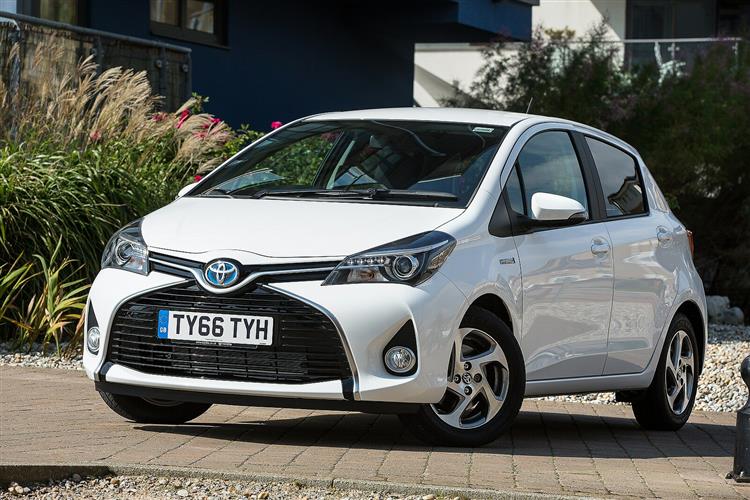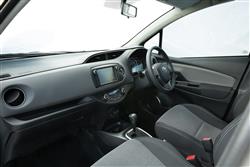This is a sample, showing 30 seconds of each section.
HY FRUGALITY (some text hidden) SECTIONED_toyotayarishybrid031214
By Jonathan Crouch
Introductionword count: 71
Aimed directly at city-living eco-minded buyers, the improved version of Toyota's third generation Yaris Hybrid that sold between 2014 and 2017 was cheaper, cleaner and more frugal than any conventional hybrid model we had previously seen. It may not be the small car you've always dreamed about but if you're urban-based and looking for a frugal supermini made in this period, it could very well be the one you actually need.
Modelsword count: 3
5dr (1.5 Hybrid)
Historyword count: 243
Having originally introduced the idea of a hybrid car, it fell to Toyota to democratise it. To make petrol/electric power more widely accessible, something only possible if it became more affordable. In a car like this, Toyota's Yaris Hybrid. The Yaris Hybrid was first introduced here in the Summer of 2012 as the industry's most affordable hybrid car, the model that finally properly opened up hybrid ownership to the urban-based market segment that in theory should take to it most, that of superminis. Here, we're looking at the improved version of the MK3 model, updated in mid-2014 with sharper looks and small improvements in cleanliness and frugality. It was a car that remained the cleanest means of automotive transport in its period, assuming you discount the pricey plug-in and battery-powered models sold in this time. Quite a claim. Though this wasn't the market's very first hybrid supermini, it was the first able to improve upon the running costs of comparable eco-conscious diesel models in this segment, while matching (or beating) them on price. Which made this model a game-changer in its town-targeted market sector and, in theory at least, an difficult option to ignore for those supermini customers looking for a small hatch from the 2014-2017 period who spend much of their lives in the kind of stop-start traffic where hybrid technology really comes into its own. This car sold until the Spring of 2017, when it was replaced by another facelifted model.
What You Getword count: 541
Not only will you struggle to recognise this car as a hybrid, you'd also have a job to tell it apart from any other conventional Yaris from the 2014-2017 era. All of which is entirely intentional of course. The days of enviro-conscious buyers wanting to trumpet their eco-minded pretentions are, thank goodness, rapidly drawing to a close. Choose one of these and your neighbours won't know that you're doing your bit for the polar icecaps - unless perhaps they look a little more closely. Those who do exactly that might clock the hybrid badging and the unique piano black lower front grille with its satin chrome surround. The better informed amongst them might even note the 20mm of extra front overhang necessary to accommodate the Hybrid Synergy Drivetrain. Otherwise though, giveaways to this car's petrol/electric status are few. Here, we're looking at the first of the MK3 Yaris's facelifts made in 2014, recognisable by an X-shaped frontal graphic that gives this supermini a sharper and more assertive look. Inside at first glance, it's all familiar third generation Yaris stuff, but look a little closer and differences begin to emerge. The little blue CVT auto gearknob, the blue stitching around the steering wheel and the handbrake and the blue and white backlighting around the sliver-ringed instruments. Come to think of it, the instrumentation's different too, with a hybrid system indicator replacing the usual rev counter, with a dial that'll see the blue needle in either 'Charge', 'ECO' or 'Power' zones, depending on the way you're driving. Much more informative about the cleverness going on beneath the bonnet though, is the blue-lit hybrid energy monitor you'll find on the display of the improved Toyota Touch 2 infotainment screen showing you at any given time what's charging or being driven by what. It would be reasonable to expect the usually rather bulky 144V nickel-metal hydride battery pack necessary for hybrid motoring to impinge upon interior space. It doesn't. The battery pack sits snugly alongside the fuel tank under the rear seat - which is why you can't slide or recline this bench. And a novel transaxle houses the electric motor, the generator, the power split device and double-motor reduction mechanism that the Hybrid Synergy Drive system needs all in a compact transmission casing that's directly comparable in size to a conventional gearbox. Very interesting no doubt for technophobes but all potential owners really need to know if this: that in this car, you get just as much room for people and packages as you would in any normal third generation Yaris. If you're not familiar with one of those, then we'll tell you that on this back seat, there's comfortable room for two adults but, as usual in this class of car, three would be a bit of a squash. At least headroom is less of an issue in this generation of Yaris thanks to an increase of 30mm in height over its predecessor. Luggage-wise, there's 286-litres of baggage room with all the seats in place. If you need more, fold the 60/40 split-folding EasyFlat rear seats down and you're treated to one of the larger stowage areas of any supermini - 696-litres - and it's perfectly flat. Overall then, a masterpiece of packaging.
To see the full road test text contact us on 0330 0020 227
Pictures (high res disabled)

.jpg)
|
.jpg)
|
.jpg)
| |||
.jpg)
|
.jpg)
|
.jpg)
| |||
.jpg)
|
.jpg)
|

|
Scoring (subset of scores)
Category: Hybrid, Plug-in, Electric & Hydrogen
| Performance | |
| Handling | |
| Comfort | |
| Space | |
| Styling, Build, Value, Equipment, Depreciation, Handling, Insurance and Total scores are available with our full data feed. | |



